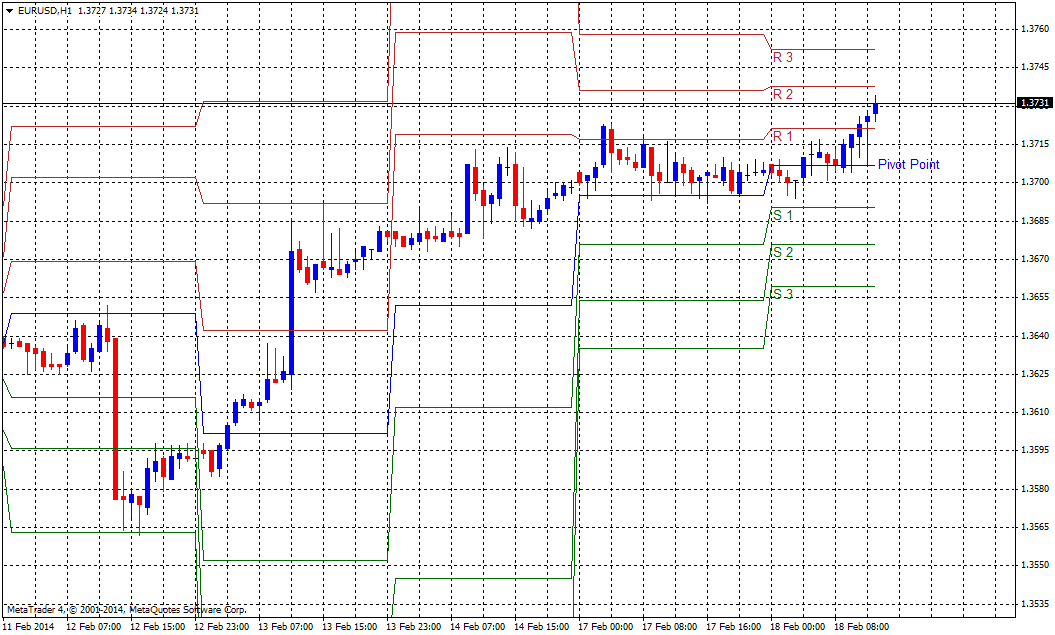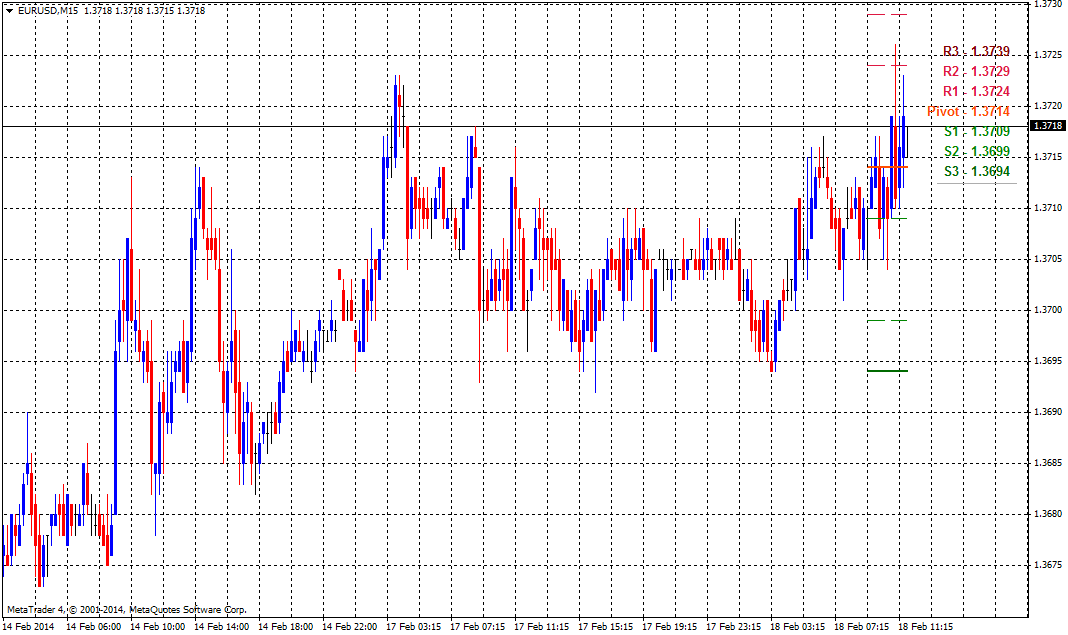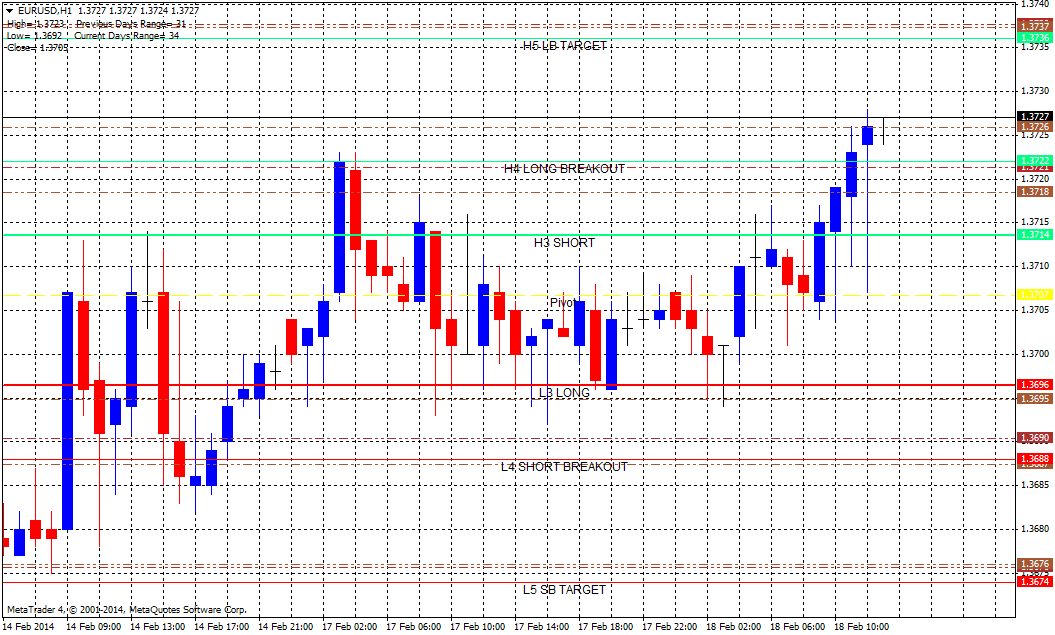Pivot Points, one of the basic and most important technical tools and the important one, is in the was used long before the era of computerized trading. The mathematical calculation of various support and resistance levels, based on the high, the low and the closing prices of the previous period, was initially used by floor traders in order to trade efficiently. The indicator was strong enough to be considered for included in technical analysis, resulting it to be and as a result you can find it present in the majority of trading platform. The basic use purpose of Pivot Points (PP) is to determine the important support and resistance levels. It is also used to determine market sentiment: as during the trending market,when the market is trending prices would will fluctuate from support PP to resistance PP, while in times of whereas when the market is directionless or ranging market, prices usually fluctuate around two PPs until a breakout happens. If prices are trading above the pivot point it is considered to carry bullish sentiment, while trading below the pivot point usually suggests indicates bearish sentiment. Moreover, Pivot Points are also an important technical tool for placing trade orders.
Calculation
Although there are several methods for calculating Pivot Points, the most common of them is the Standard Pivot Point system. It uses the simple arithmetic average of the high, the low and the closing prices of the previous trading period in order to determine the Pivot Point, i.e. the very base for calculating various support (S) and resistance (R) levels. Daily PPs are usually calculated based on the New York closing time, i.e. 16.00 EST (22.00 CEST).
- Pivot point (PP) = (High + Low + Close) / 3
- First resistance (R1) = (2 x PP) – Low
- First support (S1) = (2 x PP) - High
- Second level of support and resistance:
- Second resistance (R2) = PP + (High - Low)
- Second support (S2) = PP - (High - Low)
- Third level of support and resistance:
- Third resistance (R3) = High + 2(PP - Low)
- Third support (S3) = Low - 2(High - PP)
Types of Pivot Points
This mathematical calculation applies only to Standard PPs.. With the invention of computerized trading a lot of other PPs have been developed to assist traders:
Standard PP indicators: The very basic Pivot Point calculation starts with the Standard PP Indicators that are identical to the ones described above. These Pivot Points are the corner stone for the rest of the PP calculations. Even though the Standard PP is very helpful, it still has its own limitations as it is a mathematical calculation that sometimes misses the important support and resistance levels. In the example below, we can see six potential Standard PPs plotted on a EURUSD H1 chart.

Fibonacci PPs: Fibonacci Pivot Points are an extension of the standard PPs where Fibonacci multiples of the high-low differential are considered to form various support (S) and resistance (R) levels. You can calculate the Fibonacci PPs in the following way:
- Pivot Point (PP) = (High + Low + Close)/3
- Support 1 (S1) = P - {.382 * (High - Low)}
- Support 2 (S2) = P - {.618 * (High - Low)}
- Support 3 (S3) = P - {1 * (High - Low)}
- Resistance 1 (R1) = P + {.382 * (High - Low)}
- Resistance 2 (R2) = P + {.618 * (High - Low)}
- Resistance 3 (R3) = P + {1 * (High - Low)
In the example below, we can see six potential Fibonacci PPs plotted on a EURUSD H1 chart. Even though the Fibonacci levels are blend with Pivot Points, these Fibonacci PPs are unable to mark all the important support and resistance levels.

Hourly PP: These pivot levels are accurate enough for smaller time frames and can help traders capitalize on the little movements of the pair. Hence, Hourly Pivot Points are mainly used for Scalping. The Basic Calculations are as simple as the standard time frame but in this case the high, the low and the closing prices of the previous hour are considered in plotting various support and resistance points. In the example below, we can see six potential Hourly PPs plotted on a EURUSD M15 chart. We can see that major supports and resistances took place near the Hourly PPs, which proves the importance of this indicator. Due to the perfection in smaller timeframes, these PPs become less helpful while plotting on higher time frames (Daily, Weekly, Monthly, etc.).

WOODIE Pivot Point: While all the mentioned PPs consider only the high, the low and the closing prices for calculation, Woodie Pivot Points consider all the four indicators for movement: open, high, low and closing prices. High and low prices usually show the extreme moods of traders and hence fail to mark the important levels. Open and closing prices are considered to represent traders’ intentions more accurately, which makes Woodie Pivot Point popular among traders. The following EURUSD M15 chart describes major support and resistance levels covered by the Woodie PP. Despite all the advantages, the simplicity of the Woodie PP makes it less famous than, for example, Camarilla or Murray Math PP. In addition to that the Woodie PP doesn’t propose any strategy as other advanced PP do, which also makes it less useful for big banks and professional traders.

Murrey Math PP: One more technical indicator based on the Pivot Point is Murrey Math. It tackles with a lot of limitations of Standard, Hourly and Fibonacci PPs. and is widely used by professional traders and big banks. The indicator is divided into eight lines that mark multiple support and resistance levels. It also mentions the major reversing point (Line 4/4) and the Ultimate Support and Ultimate Resistance lines (line 0/8 and line 8/8 respectively). As you can notice on a EURUSD M15 chart below, the major support and resistance levels are covered by the Murrey Math PP. The indicator divides the chart in nine equidistant lines, from the bottom are at the levels 0/8, 1/8, 2/8, 3/8, 4/8, 5/8, 6/8, 7/8 and 8/8. The mentioned PP lines can indicate when to go long/short as well as important stop-loss and take profit points.

Camarilla: Camarilla is one more advanced PP indicator which helps traders in Scalping and Day trading. It is also one of the renowned technical indicators for professional traders at big financial institutions and banks. It is a price-based indicator for defining the trading levels. Each point calls for specific actions and hence becomes different from the rest of the PPs. The mentioned PP lines can indicate when to go long/short as well as where important stop-loss and take profit points are. You can calculate various levels with Camilla Technical Indicator in the following way:
H5 = (High/Low) × Close
H4 = Close + RANGE × 1.1/2
H3 = Close + RANGE × 1.1/4
L3 = Close – RANGE × 1.1/4
L4 = Close – RANGE × 1.1/2
L5 = Close – (H5 – Close)
The following H1 EURUSD chart describes how Camarilla marked the important support and resistance levels together proposing important trading strategies.

Concluding Remarks
Contrary to the popular perception, pivot points don’t only calculate various support and resistance levels, but also offer some valuable trading strategies. Furthermore, various types of PPs help traders in capitalizing on the movement of different currency pairs. Moreover, using only Pivot Points for confirmation is not enough for making a wise trading decision. It should also be backed by other technical indicators like, moving averages, RSI, MACD, etc.
The analysis and the article presents Nenad's opinion. Remember, financial trading is highly speculative & may lead to the loss of your funds. Proper risk management is the Holy Grail of trading.
Editors’ Picks
AUD/USD pressures as Fed officials hold firm on rate policy

The Australian Dollar is on the defensive against the US Dollar, as Friday’s Asian session commences. On Thursday, the antipodean clocked losses of 0.21% against its counterpart, driven by Fed officials emphasizing they’re in no rush to ease policy. The AUD/USD trades around 0.6419.
EUR/USD extends its downside below 1.0650 on hawkish Fed remarks

The EUR/USD extends its downside around 1.0640 after retreating from weekly peaks of 1.0690 on Friday during the early Asian session. The hawkish comments from Federal Reserve officials provide some support to the US Dollar.
Gold price edges higher on risk-off mood hawkish Fed signals

Gold prices advanced late in the North American session on Thursday, underpinned by heightened geopolitical risks involving Iran and Israel. Federal Reserve officials delivered hawkish messages, triggering a jump in US Treasury yields, which boosted the Greenback.
Runes likely to have massive support after BRC-20 and Ordinals frenzy

With all eyes peeled on the halving, Bitcoin is the center of attention in the market. The pioneer cryptocurrency has had three narratives this year already, starting with the spot BTC exchange-traded funds, the recent all-time high of $73,777, and now the halving.
Billowing clouds of apprehension

Thursday marked the fifth consecutive session of decline for US stocks as optimism regarding multiple interest rate cuts by the Federal Reserve waned. The downturn in sentiment can be attributed to robust economic data releases, prompting traders to adjust their expectations for multiple rate cuts this year.
RECOMMENDED LESSONS
Making money in forex is easy if you know how the bankers trade!
Discover how to make money in forex is easy if you know how the bankers trade!
5 Forex News Events You Need To Know
In the fast moving world of currency markets, it is extremely important for new traders to know the list of important forex news...
Top 10 Chart Patterns Every Trader Should Know
Chart patterns are one of the most effective trading tools for a trader. They are pure price-action, and form on the basis of underlying buying and...
7 Ways to Avoid Forex Scams
The forex industry is recently seeing more and more scams. Here are 7 ways to avoid losing your money in such scams: Forex scams are becoming frequent. Michael Greenberg reports on luxurious expenses, including a submarine bought from the money taken from forex traders. Here’s another report of a forex fraud. So, how can we avoid falling in such forex scams?
What Are the 10 Fatal Mistakes Traders Make
Trading is exciting. Trading is hard. Trading is extremely hard. Some say that it takes more than 10,000 hours to master. Others believe that trading is the way to quick riches. They might be both wrong. What is important to know that no matter how experienced you are, mistakes will be part of the trading process.

